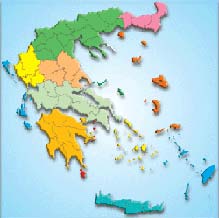
Please click on the map,
the region you want to visit |
|
|
|
|
| |
|
 |
Tourist Guide of Meganisi |
|
 Meganissi is a beautiful, picturesque and greenfull small island, but with a great length of beaches and a cultural heritage, in the Ionian Sea, very close to Lefkada. Meganissi is a beautiful, picturesque and greenfull small island, but with a great length of beaches and a cultural heritage, in the Ionian Sea, very close to Lefkada.
Just 4 nautical miles (South east) separates it from the island of Lefkada and there are several neighboring islands around it such as Scorpios, Scorpidi, Thilia, Kithros, and more.
You can arrive there by a ferry boat from Nidri and you will have the opportunity to see the Madouri, with the old mansion of Valaoritis and Scorpios, owned by the Onassis family.
The island has a fairly good road network and local transportation.
Its area is about 20 sq. km., and it belongs to the prefecture of Lefkada.
It consists of three picturesque villages: Vithos, Katomeri and Spartochori with their picturesque harbors: Vathi, Atherinos and Spilia. Each, with its own beauty and charm, constitutes the main settlements with about 2,000 residents.
Capital of Meganissi is Katomeri which is also the capital of the municipality.
The hospitality of the local people with their quiet life, the traditional architecture, the beautiful landscapes, the wonderful coves with the traditional taverns and the crystal clear sea are a magnet for lovers of special vacations.
The island is visited annually by many local and foreign tourists, and it has fairly well developed marine tourism and hotels, rooms and apartments of various categories.
 Lovers of hiking can enjoy the scenic route to the cape Kefali, the narrow and long "leg" of the island, and they will be compensated by the magnificent views of the spectacular sea and the wonderful scattered islands. Lovers of hiking can enjoy the scenic route to the cape Kefali, the narrow and long "leg" of the island, and they will be compensated by the magnificent views of the spectacular sea and the wonderful scattered islands.
You can do windsurfing in the area of Agios Ioannis, biking with pedal boats in Spilia and sailing in the most areas around the island.
It is worth visiting the old church of St. John, at the homonym beach, the cave of Papanikolis by boat, which is said to be the lodging of the submarine Papanikolis, the Giovani cave, the Daimonas cave  and also it is worth doing the round of the island.
Some of the most popular beaches are: Agios Ioannis, Pasoymaki, Ampelakia, Atherinos, Faros, Limonari, Elia, Loutrolimni, the Bereta and at the most south-eastern place of the island is Fanari which has a beautiful small sandy beach.
The many and wonderful coves of Meganissi are natural harbors that many owners of small and large boats prefer. and also it is worth doing the round of the island.
Some of the most popular beaches are: Agios Ioannis, Pasoymaki, Ampelakia, Atherinos, Faros, Limonari, Elia, Loutrolimni, the Bereta and at the most south-eastern place of the island is Fanari which has a beautiful small sandy beach.
The many and wonderful coves of Meganissi are natural harbors that many owners of small and large boats prefer. |
|
 |
HISTORICAL FACTS:
People had lived at Meganisi during the Neolithic era. The first name of the island was Tafos, from the name of the son of Hippothoe, the daughter of Lelegas and Poseidon. Homer mentions that Anchilaos reigned in the Taphius, a wise man and a very close friend to Odysseus, and after him his son, Mentis (with his body-form Athena was presented to Telemachus) and they were exceptional traders, because only them were marketed iron, were capable and brave sailors and navigators, competing with the Phoenicians.
Some Latino authors argue that the ancient island of Capri (the known Capri of Italy today) was a colony of Tafion. Generally, in the ancient and historic year, Meganissi followed always the same history and fate with Lefkada. In the 7th century BC was occupied by the Corinthians (who built the current channel of Lefkada) and followed its own route until 197 BC when it was conquered by the Romans.
After the occupation of the city from the Franks (1204), ceded to the Venetians, but the Domain of Epirus annexed the islands (1204-1294). Then, was the Frankish occupation (1294-1479) and soon after Meganissi, as Lefkas, came to the Turks and remained at their sovereignty until 1684, when occupied by the Venetians.
In 1797, the French obtained the island, and a year later, in 1798, the Russian-Turkish took it. In 1800, it was founded the State of the Ionian Islands and was maintained until 1807. But the people asked for more rights while Meganissi was always been the refuge of Armatolon and Klefton and of all the suppressed by the Turks.
The Imperial French became the masters of Meganissi from 1807 to 1809. In 1810, it was conquered by the British. In the National Revolution of 1821, Meganissi actively participated with great enthusiasm and even distinguished one of the most talented chieftains of the Revolution, Dimos Tselios (Demetrius or Dimos Ferentinos), the known "Geros Dimos" of the famous song (Spartochori Meganissi 1785 - Agrinio 1854).
Finally, on 05/21/1864, Meganissi, as thus Lefkada and the other Ionian Islands, were united with Greece repealing the English occupation.
| Source:
Municipality of Meganisi |
|
|
|
|